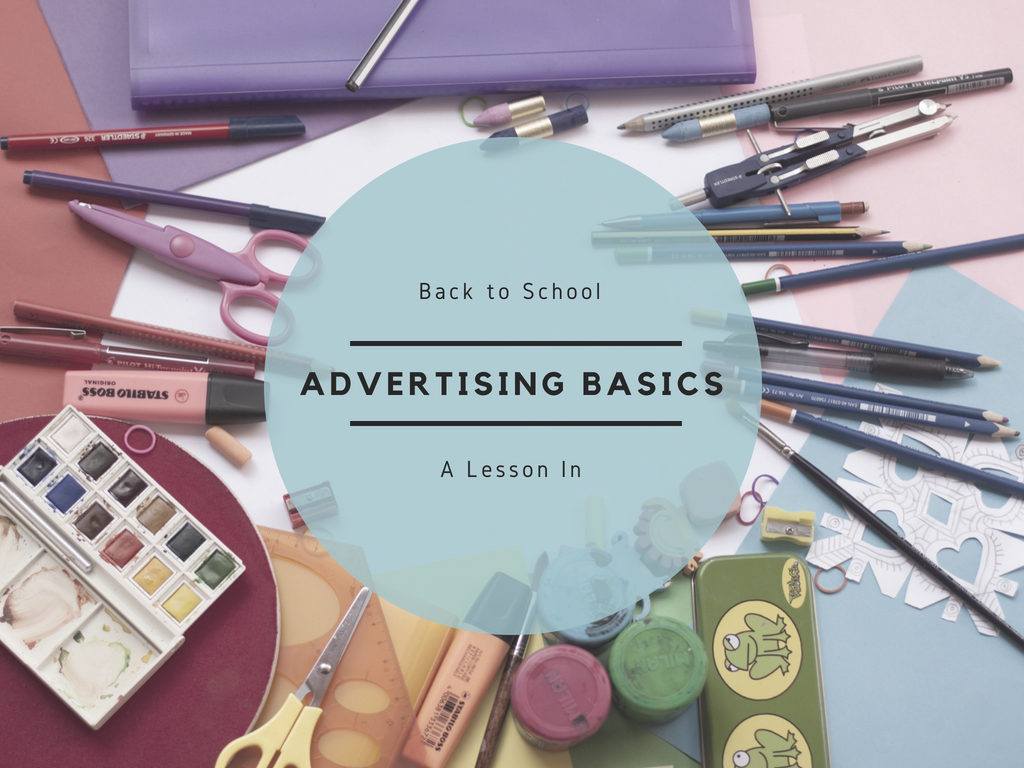
Back to School: A Lesson in Advertising Basics
Back to school time is right around the corner (don’t tell the kids). While you might not be heading back to the classroom, you can always take a little time to learn. Today, we’re going over the advertising basics, from the best fonts to use to how to pick the best colors. So find a desk, grab your pencil, and let’s head back to advertising school.
Lesson #1: Research Your Audience
This is the first and most basic thing you need to know before advertising. Your target audience will determine everything else you do as a brand, from your packaging to your placements.

Finding your audience is one of the most important steps you can take prior to starting a campaign.
Before you start randomly picking outlets to advertise with, sit down and analyze your consumers. How old are they? Are they primarily male or female? Where do they live? The answers to these questions will help guide you toward picking the best spaces for your ads.
Lesson #2: Spruce Up Your Website
This is a step that many advertisers overlook. While fixing up your website doesn’t seem like it would be necessary to run an advertising campaign, it can have a huge impact on your campaign’s performance.
If potential customers can’t navigate your website, can’t find products they want, and don’t think the page looks trustworthy and professional, they’re going to leave without making a purchase. You don’t want that to happen. Make sure your ads lead to conversions by cleaning up your website prior to beginning a campaign.
Even if your advertisements are beautiful and succeed in directing traffic to your website, you still need to convert those visits to sales. You want your customers to have a pleasant shopping experience that ends with a purchase; a well-designed website will help ensure that happens.
Lesson #3: Create Some Creative
Since we’re on the topic of creating beautiful advertising, let’s dive a littler deeper into what that really means. Obviously creating visually appealing advertisements is one of the most, if not the most, important lessons in advertising. When you advertise, you’re relying on your ad to draw consumers in to make a purchase. Most of the time, you don’t get to speak to potential consumers in-person; you only get a single page to tell your story.
Your creative needs to be eye-catching, yet simple. It needs to explain your product and tell your story without overwhelming the reader. Most importantly, it needs to sell. That’s a lot of requirements for a single piece of paper, but don’t get overwhelmed. Start your creative process by focusing on these things:
1. Pick a simple font
Start designing your creative with a simple, easy-to-read font. Here are some of the best to choose from. Stay away from fancy, cursive fonts. You might think they look nice, but they can become messy and hard to read in small spaces.
2. Choose your colors wisely
Colors are more important than you might think. They can sway a potential consumer to purchase, or drive them away. Make sure you’re choosing colors that compliment your product, your audience, and your advertising goals.

When designing creative for an advertisement, choose your colors wisely.
3. Select high-quality, clean images
Like we mentioned earlier, you’re relying on an image to entice potential consumers to make a purchase. That means you better use a good one! Pick an image that’s clear, focused and professionally done. Photos taken with your iPhone camera probably aren’t going to cut it.
Make sure your image showcases your product and also tells consumers where they can purchase it. Don’t forget to include a website name, or store where your product can be found.
Lesson #4: Pick Your Placement
Now that you know your audience and you have your creative, you can start looking for outlets where you’d like the run your advertisement. This will largely depend on your audience demographics, so look for outlets that match up well with your target consumer. You can verify this information by looking and media and press kits from magazines and websites you’re interested in.
When picking your placements, it’s important to keep a few other things in mind, as well:
1. Frequency
Don’t just book one advertisement in one magazine! This likely won’t yield great results, as consumers typically need to see your ad three times before making a purchase. Shoot for three to six placements to start with. Repeated exposure will familiarize consumers with your product and brand, making them more likely to purchase.
2. Variety
It’s also important to try out a variety of media. Split your placements across print, digital, social media, television, etc. to get the maximum number of eyes on your ads. However, keep your target audience in mind here, too. If your product is geared toward 65-70 year olds, advertising on Instagram probably isn’t going to result in a great ROI. Stick with the media you know your audience uses.
Lesson #5: Observe, Test and Change
Advertising is a science. It’s also an ongoing process.
Your campaign doesn’t stop once your ad hits newsstands. Now you need to observe the campaign. Did you see an increase in sales? Was your coupon code used? Did your website traffic increase? If you don’t monitor your campaign, you’ll never know the results. Knowing the results can also help you create a better campaign next time. Just because one campaign went poorly doesn’t mean you should stop advertising forever. Instead, start at the top of this article and begin again. Maybe your audience isn’t who you thought. Maybe your website could be improved. There’s a million ways to improve your campaign.
While there’s always more you can learn about advertising, these back-to-school basics are a great place to start your campaign. You can also check out our editorial calendar to start planning your back to school advertising by clicking here.
